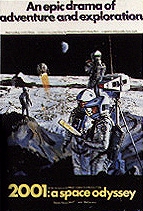
"2001: A Space Odyssey" (1968)
Summary
This movie is based on a short story by Arthur C. Clarke. "On Earth, hominids touch a large, mysterious black slab and conceive of weaponry. On the moon, in 2001, a second black slab is discovered and emits a piercing sound in the direction of Jupiter (Saturn in the novel.) The spaceship Discovery, already under construction as part of Project Jupiter, is sent to find out who or what is on the receiving end of the signal. En route, the computer HAL goes berserk and kills the hibernating astronauts and astronaut Poole before (Commander Dave) Bowman is able to disconnect all but his vital functions. Reaching Jupiter, Bowman leaves the Discovery behind when he's drawn into a stargate. He ends up in a comfortable room on an alien world, where his life passes uneventfully; upon his death, he is reborn, courtesy of a third slab (and the unseen aliens) as a starchild, return to watch over Earth." (Rovin, p.76-77)
Questions
1. What is the role/function of robot? Why was it created?
HAL-9000 controls the vital functions and the electronic systems of the Discovery. "Only HAL knows the real mission of the trip, but he has been programmed to withhold the information from the astronauts until the spacecraft is almost to Jupiter." The origin of the name "HAL" is debatable: some see its significance as the three respective letters that come before the name of the company "IBM"; others claim "HAL" means "Heuristically programmed ALgorithmic Computer." Either way, HAL is programmed to learn from its experiences.
2. How human is it? How human is it meant to be?
HAL has anthropomorphic qualities, especially since he speaks in a gentle male voice. He is programmed to express real human emotions. Although lacking the sinew and bone of a mobile physical being, HAL seems human. Built to explore, communicate and discover, HAL watches everything that happens on board the Discovery through his unblinking red lens eye.
3. How does it act in society? How do humans react to it?
In interaction, HAL is a very pleasant computer. He was designed to operate in conjunction with humans. Until HAL malfunctions, people treat him as a computer, but not necessarily as a sentient being. All in all, the humans in the film seem rather immune to HAL's suffering. When it becomes apparent that HAL is going haywire, there seems no question in Dave Bowman's mind that he should disconnect the computer.
4. What are the consequences within the context of the world of the work?
HAL's malfunctioning makes it impossible for the humans to return to Earth. Once HAL begins to malfunction, he becomes increasingly aggressive. Whether he does this to guard his top-secret mission or to prevent himself from being disconnected is arguable. Nevertheless, since HAL controls the ship's crucial systems, he has power over the lives of the humans on board. Ultimately, "HAL is a tool, just as the bone was, and like the bone, it was only as good as the man who used it." (Baxter, p.183)
5. Does it introduce a new idea or aid in the evolution of the robot? i.e. What's its contribution?
HAL and "2001" established a precedence for the casting of artificial intelligences as film characters. Showing both the risks and the powers of technology, the role of HAL in the movie raises (but does not answer) many difficult questions about the relationship between human beings and what they create. Because HAL has a fatal flaw, like a good tragic hero, there is a doubt as to the superiority of machine intelligences to those of humans. But, why did HAL's creator decide to make the computer mimic human qualities? Does HAL go berserk because he is programmed not to tell a lie but is assigned to keep the goal of the mission a secret at all costs until the ship reaches Jupiter?